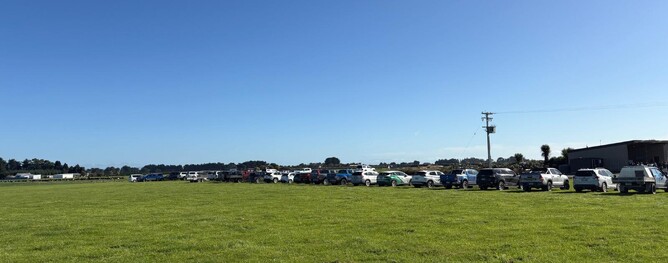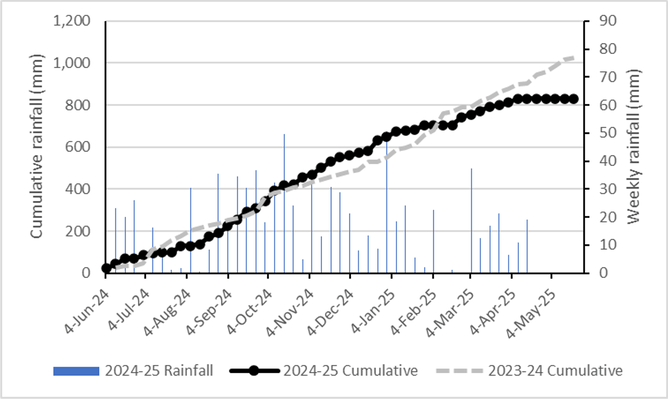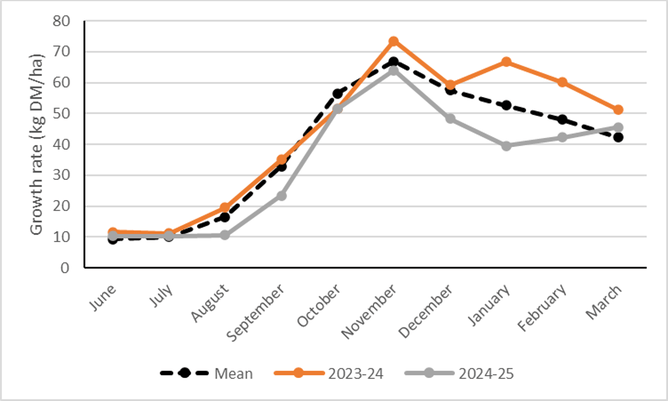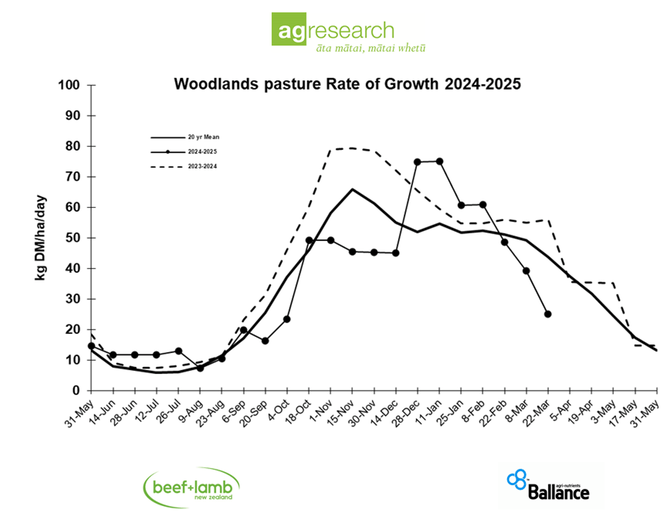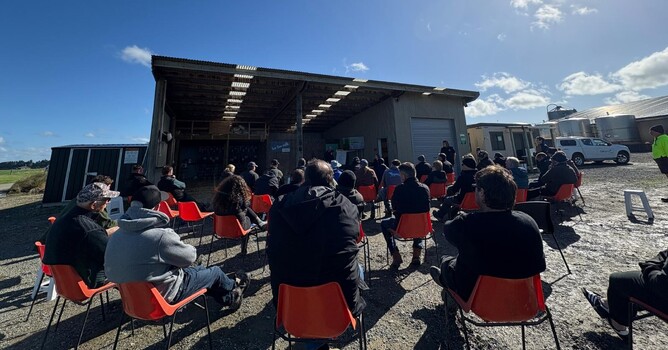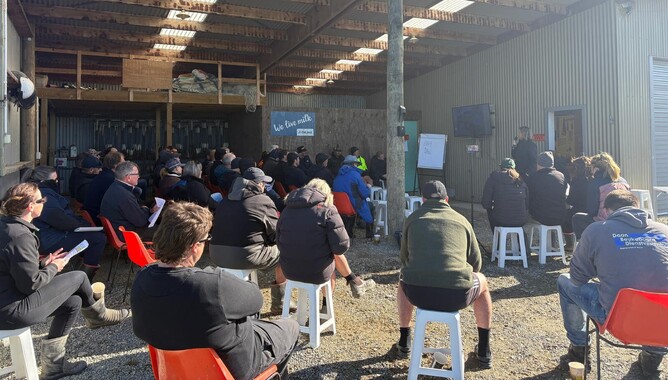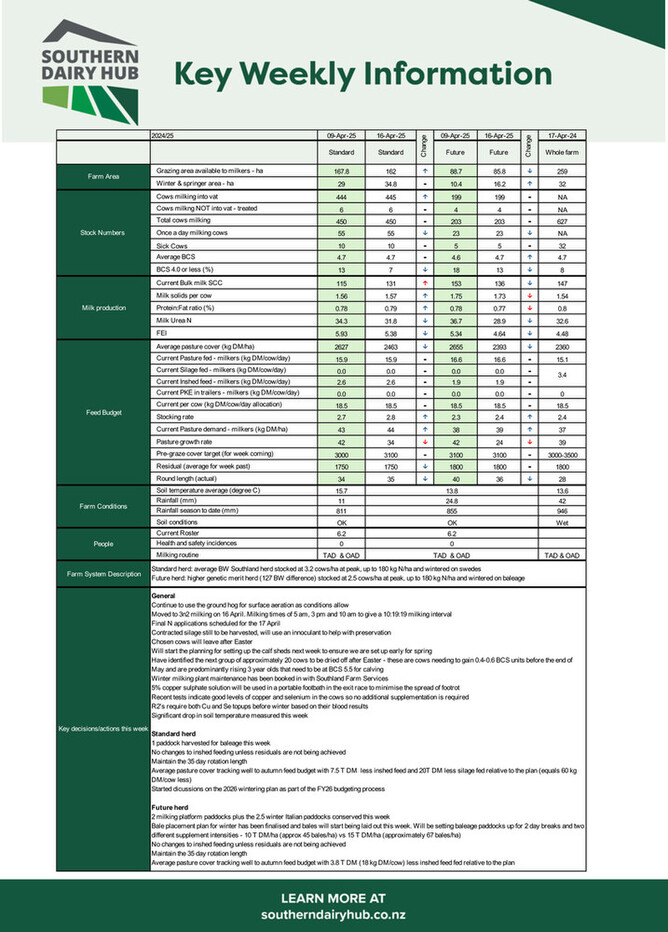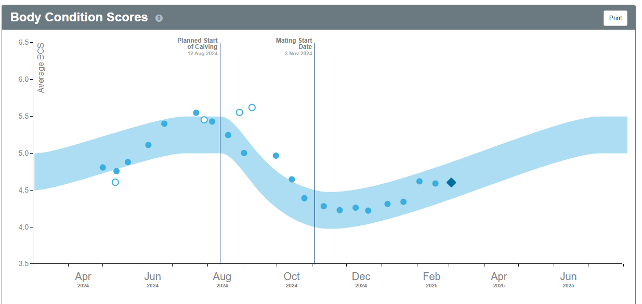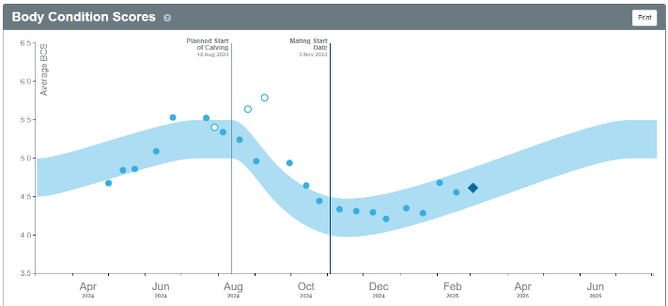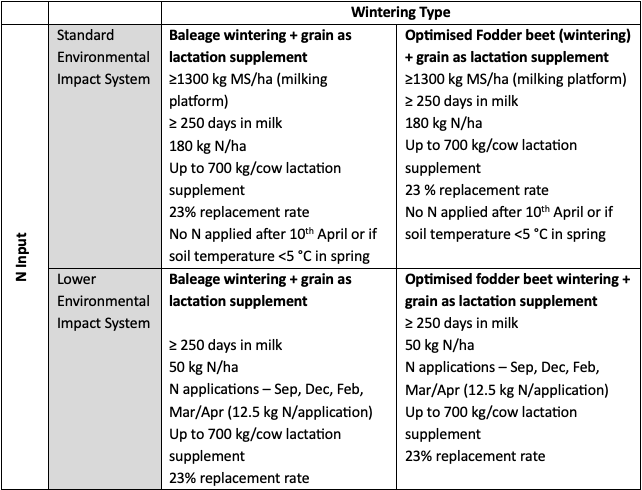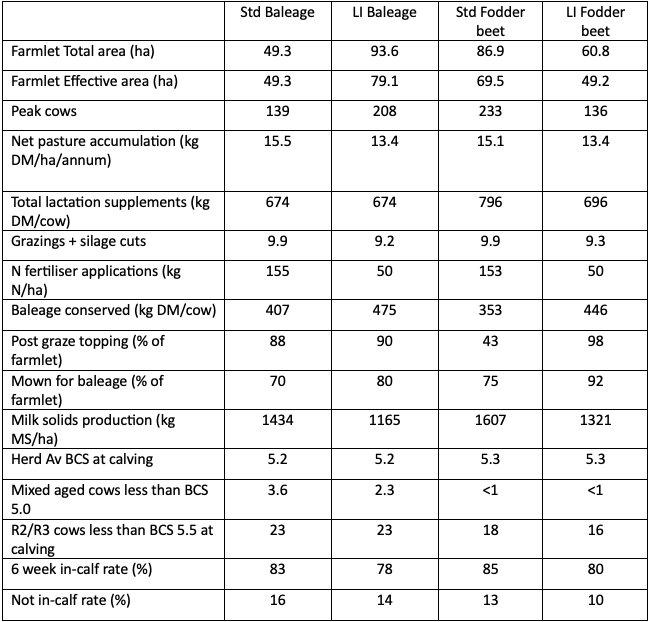Welcome to our latest newsletter from the Southern Dairy Hub. As we transition from autumn into winter preparations, we've been facing a season of extremes – higher temperatures paired with unusually heavy rainfall that's created significant challenges across our operations.
Despite waterlogged grounds and periods of drought-like conditions affecting grass growth (we've grown approximately 3 tonnes less grass compared to last season), our team continues to adapt and innovate. We've recently shifted to 3:2 milking to address lameness issues and ensure proper preparation for the upcoming winter and spring periods.
This edition highlights our successful April Field Day, which drew over 70 farmers keen to learn about profitable supplement use and effective grass management.
We're also excited to share updates on our Future Farm Systems Demonstration Trial, comparing our "Future Herd" (focused on individual cow performance at lower stocking rates) with our "Standard Herd" (reflecting typical southern South Island farming practices).
Inside, you'll find detailed insights from our reproductive review, revealing how our herds achieved a 6-week in-calf rate of 73% – above the industry average of 69.3%. We're transparent about both our successes and areas for improvement as we work toward developing more resilient farming systems.
As always, we're committed to sharing practical, data-driven insights that help you create sustainable, profitable, and environmentally responsible farming practices.
Happy reading, Andrea
From the farm
What a season we’ve had. It’s been a hot and wet one. The graph below shows the higher summer and autumn temperatures this year compared to last year, but more rain from November through to February than previous years. Given the ground was already waterlogged going into the season this has made things on farm very challenging. One minute its really wet, and then the next minute its dry and creating a seal that has limited grass growth.
This year we have certainly grown less grass which has meant we have needed to go to market to buy more baleage for our farmlet wintering systems requiring a lift in our feed budget. The Future system will be wintered on grass and baleage and the Standard system swedes and baleage.
The pugging and drainage challenges through the spring period has resulted in variability of growth across the paddocks impacting grass growth – we have grown 3T less grass season to date from season.
Pasture Growth
It’s the time of the year where we move our focus to setting ourselves up well for next season. The team are busy planning bale placement for winter paddocks, aeration and ground hogging (thanks to the local farmer who lent us their ground hog) to try and promote grass growth and deal with some of the compaction issues. Lots of cleaning by the team – they did a great job getting the dairy shed area ready for our field day last week, and are now in the process of getting the calf shed ready – the calves will be here before we know it 😊
We made the decision to move to 3:2 milking this week due to lameness challenges and to also give the team plenty of time to prepare for the winter and spring period. It will also help if the weather turns bad soon, as it did last year. We really need to protect our grass and ensure we dry off at our target (1950) and are therefore well set for spring.
Fantastic turnout at April Field Day
Over 70 local farmers, some as far afield as Balclutha turned up on a cold and windy Wednesday (15 April) to join our deep dive at the Hub into the question ‘are you making money from milk or milk from money?’
We explored profitable supplement use and effective grass management, as well as insights from the Northland Dairy Development Trust (NDDT) marginal milk trial, analysis from Conal Harkin on milk response rates and concentrate feed, and practical grass management tips. We heard how to minimise supplement wastage, with advice to carry a buffer to ensure resilience through the troughs of the season (our guest speaker carries 50% season silage requirement as a buffer). We learnt about preserving high quality feed, monitoring pasture residuals daily to minimise pasture wastage, how the milk response from concentrate supplement can vary depending on post grazing residual levels and how to use residuals rather than production to drive supplement decisions.
If you missed the day – and the delicious lunch thanks to PCG Wrightson – we’ve put the presentations onto our website and a short video from Kim Robinson (NDDT) with her key takeaways and tips.
Update on the Hub’s Future Farm Systems Demonstration Trial
If you get our HubWatch weekly notes, then you know that something exciting has been happening at the Hub.
A recent survey told us that what you wanted was more real-time data, providing insights into different systems that showcase levers to pull to create sustainable, profitable, and environmentally responsible farming practices. So, this is what we’ve done. We are currently running a multi herd comparison that measures the performance of two contrasting farm systems: a standard herd and a future herd. We are using different parameters, feed, and wintering practices.
Farmlet 1: Future Herd – focused on greater individual cow performance at a lower stocking rate with less supplementary feed, a lower environmental footprint (methane, carbon, nitrate leaching), and emphasis on animal welfare (from an already high bar) and cow comfort.
Farmlet 2: Standard Herd – has a higher stocking rate, a stronger focus on profit, and closely reflects a ‘typical’ farming system in the southern South Island.
You can learn more about what results we’re sharing by watching this short video featuring Hub GM Andrea Dixon, and Lead DairyNZ Senior Scientist Dawn Dalley.
Each week we are sharing our insights on the Facebook page, website and sending an email to our mailing list. If you’re keen on getting these results on email, sign up here (bottom of homepage).
Repro Review – Mating 2024
Over the past season, we have conducted a reproductive review of our herd, assessing matings, conception rates, body conditioning scores, and 6-week in-calf rates (6WICR).
From 1 September 2024, the Southern Dairy Hub Future Farm Systems Demonstration trial separated the herd into two:
The Future herd – Higher genetic merit cows (127 BW difference) with a lower stocking rate (2.5), less imported lactation supplement, wintered on baleage.
The Standard herd – average BW Southland herd stocked at 3.2 cows per ha wintered on swedes.
This allowed us to complete the DairyNZ winter 2024 farm systems trial before distributing the cows. It has, however, made interpreting the results a little more challenging as the cows were sitting in different herds through calving.
Mating Performance
The herds averaged a 6WICR of 73% (Future herd: 71%, Standard herd: 75%). These results are slightly lower than last season’s results (74%) but still above the industry average of 69.3%.
Our two-year-old calving pattern among the Standard herd is excellent (97% 6WICR), with both Standard and Future two-year-old herds averaging 95% and 93%.
As expected, the 6WICR across the combined herd steadily declines as the cows age (two-year-olds: 81%, three-year-olds 75%, 4-8-year-olds 71% and 9+ year-olds 69%). Given that our three-year-olds comprise 20% of the herd, these results were significant.
This is reflected in the conception rates, with two-year-olds recording a 67% conception rate in the first three weeks compared to 59% for three-year-olds and an average of 54% for cows aged 4+. Interestingly, the two-year-olds recorded a 0% conception rate after 9+ weeks, which LIC tells us is highly unusual.
The overall conception rate was 52% (MINDA). When we delve into the data at a combined herd level, the conception rates across the board in the first three weeks were poor (average: 46%) compared to the second three weeks (63%), resulting in lost days in milk. This has been traced back to a problem with dry matter intake leading up to mating, particularly in October. The sodden conditions we were farming in last spring certainly had an impact. Very limited pasture availability and high feed wastage negatively impacted dry matter intake and the energy balance of the cows. The damage to paddocks has impacted farm grass growth all season. We have been reminded of the critical importance of cow nutrition to dairy farm productivity, as it underpins cow production and reproductive performance and therefore farm profitability.
Body condition scores
Body condition scores recorded reflect the repro performance among the various age groups. The two-year-olds averaged 4.6BCS going into mating, which likely reflects their excellent 6WICR.
The mixed-aged cows had the lowest performance, and we can see from our BCS data that they were a little heavy at calving (5.5BCS) and then dropped 1.5BCS by mating (higher than the target of less than 1BCS). Mobilising too much body fat and protein has likely had an impact on our early days of mating. It took a good three weeks into mating for us to get them on a rising plane of nutrition.
Interestingly, both the Standard and Future herds gained BCS while still milking – not many cows manage to achieve this, according to LIC’s MINDA data. This bodes well to maximise days in milk in the later part of lactation, provided the cows are not too heaving going into calving.
Standard Herd BCS
Future Herd BCS
What went well?
When we think back on the things that worked well leading into mating one of them was the separation of the two- and three-year-olds into their own mob in early September. This age group has certainly performed a lot better across the board. When cows are moved into different mobs, there is a change to the social hierarchy. We know that young cows are more likely to be bossed around by the older girls, so having the young cows in their own mob likely reduced the level of social stress that they had to contend with as they recovered from calving.
What could we have done differently?
Looking back, we could have better-managed pasture utilisation and balancing nutritional requirements for our mixed-aged cows through the wet period. While our focus at the time was trying to minimise BCS loss the utilisation of feed was a challenge.
We are in the process of developing a plan for the upcoming season including:
Having a full farm team pre-calving and pre-mating session including our rural professional support networks to ensure a thorough and robust plan.
Managing BCS so cows can stay on maintenance diet over winter (or gain just a little) ensuring the mixed-aged cows especially are at target weight at calving (not too over conditioned)
A real focus on the transition to lactation with this plan being in place from 1 June 2025
Consideration of higher use of synchrony to regain some of the lost days in milk
2023-24 Farmlet comparision results
The 2023-24 dairy season was originally intended as the first year of a three-year farm systems comparison incorporating the proposed off-paddock infrastructure into one of the farmlets.
The initial design used an unbalanced 2x2 factorial, with system intensity (standard (Std) vs lower impact (LI)) and wintering type (fodder beet vs silage/baleage) comprising the two factors. The design was unbalanced due to the needs of the standard system, in which it was proposed that cows would be wintered on pasture silage in the off-paddock infrastructure while the LI system cows would be wintered on baleage (LI Baleage) in pasture paddocks within the milking platform area.
A change in funding for the infrastructure build resulted in the build being suspended however the farmlets continued to be implemented as planned, with the exception that the proposed Std Infrastructure farmlet became the Std Baleage farmlet (Table 1).
Table 1: Key physical parameters for the actual farm systems implemented at SDH.
While only being conducted for one season, the farmlet study still provided valuable learning, despite results being observational with no statistical analysis and only representing one season.
Baleage wintering:
Supplement quality is critical in systems where conserved feed makes up a significant proportion or all the winter diet. Baleage farmlets did achieve herd average pre-calving body condition score (BCS) targets but with a wider range in BCS and a higher proportion of individual animals not reaching their target.
Testing of supplement quality is essential for successful wintering outcomes in systems reliant on high intakes of conserved feed.
An 18 T DM baleage/ha ‘yield’ (80 bales per hectare) the wintering paddocks at SDH did not consistently provide better conditions for cattle compared to crop paddocks and the paddocks had to be fully regrassed at the end of the winter.
Increasing pre-graze mass to 2800 kg DM/ha did improve the ground conditions during grazing but there were still significant periods during the winter when cows were standing on bare soils with very little soil armouring.
Farm systems with baleage wintering:
Managing pasture quality during lactation in lower stocking rate systems wintering on baleage required significantly more mechanical intervention (post graze topping or conservation) than the equivalent system wintering on fodder beet.
A lower stocking rate did not result in increased per cow production (Table 2) due to losses in pasture quality resulting from delays with harvesting surplus pasture. Timely decision making and conservation management is key to achieving good pasture quality and milk production outcomes.
Lower stocking rates do provide an opportunity to be more self-contained for winter baleage compared with higher stocked systems but still rely on purchased supplement for wintering given a 100% baleage diet.
Optimising fodder beet wintering:
By removing cows from fodder beet 28 days before their expected calving date we encountered less metabolic issues at calving than had previously been experienced with cows wintered on fodder beet and transitioned straight from beet into the springer mob.
A higher peak milk production was achieved from the optimised fodder beet wintering regime compared with those wintered on baleage and was similar to that measured from cows wintered on kale in previous seasons.
While the proposed three-year farmlet study could not be completed due to funding changes, valuable lessons regarding paddock-based wintering were gained from the revised one-year farm systems study.
Table 2: Summary of physical performance of the SDH farmlets for the 2023-24 season
Thanks for reading. Stay tuned for more updates or visit www.southerndairyhub.co.nz to find out more.
Kind regards,
Andrea Dixon (General Manager)

